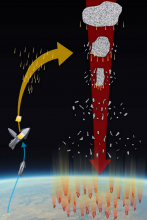Listen to today's episode of StarDate on the web the same day it airs in high-quality streaming audio without any extra ads or announcements. Choose a $8 one-month pass, or listen every day for a year for just $30.
You are here
More Moon and Planets
One of Saturn’s moons is lucky to be alive. A collision with another body billions of years ago gouged a giant crater in its surface. And it may have created a long crack on the opposite hemisphere. The moon might have survived only because it was still fairly warm.
Tethys is Saturn’s fifth-largest moon. It’s about 660 miles in diameter. Its surface is quite bright. And it’s a fraction less dense than water — the least-dense major moon in the entire solar system. That means it’s made almost entirely of ice, with only a smattering of rock.
Tethys was hit when it was still quite young. It would have been much warmer than it is today, so its interior was at least partially molten. When it was hit, that “squishy” interior probably kept the moon from being blasted apart.
Even so, the impact carved a crater, named Odysseus, that’s 250 miles in diameter. It makes the moon look like a “Star Wars” death star. And there’s a giant canyon — Ithaca Chasma — on the opposite face of Tethys. It’s 1200 miles long, up to 60 miles wide, and three miles deep. Although its origin isn’t certain, it could be a “crack” caused by the impact — a scar on a moon that’s lucky to be around.
Saturn appears near our Moon this evening. It looks like a fairly bright star to the right of the Moon at nightfall. The brighter planet Jupiter is a little farther from the Moon.
Tomorrow: A bright star loses a planet.
Script by Damond Benningfield





